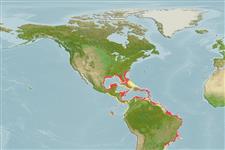Common names from other countries
Classification / Names / Names
Common names | Synonyms | Catalog of Fishes (gen., sp.) | ITIS | CoL | WoRMS
Environment: milieu / climate zone / depth range / distribution range
Ecology
Benthopelagic; brackish; depth range 0 - 75 m (Ref. 101597). Tropical; 34°N - 29°S, 98°W - 34°W
Eastern Pacific and Western Atlantic: from South Carolina to Florida and Texas, to Mexico, Belize, Guatemala, Honduras, Nicaragua, Costa Rica, Panama (Miraflores Locks), including the West Indies, to Colombia, Venezuela, the Guianas and Brazil (from Para to Santa Catarina).
Length at first maturity / Size / Weight / Age
Maturity: Lm ? range ? - ? cm Max length : 12.9 cm CW male/unsexed; (Ref. 367); 12.4 cm CW (female)
Carapace less than twice as broad as long; 9 stout teeth on strongly arched anterolateral margin, all except outer orbital tooth and short lateral spine usually swept forward; front bearing 4 well-developed teeth (excluding inner orbital angles). Coarse scattered and transverse lines of granules on convex dorsal surface. Pincers robust, ridges and crests coarsely granulate; fifth legs flattened form of paddles. Male with T-shaped abdomen reaching posterior quarter of thoracic sternite 4; first pleopods reaching slightly beyond suture between thoracic sternites 6 and 7, sinuously curved, overlapping proximally, diverging distally to tips curved abruptly inward, armed distally with scattered minute spinules. Color: adult male dorsally purplish red, more accented on proto-, meso-, and metagastric areas and at base of lateral spines and anterolateral teeth; branchial region and anterolateral teeth obscure maroon; dorsal surface of all legs purplish red with intense orange red on articulations; inferior portions of merus, carpus, and fingers of chelipeds intense violet; internal and external portion of chelae as well as remaining ventral aspect of animal white with tints of soft purple.
Maximum depth from Ref. 105697.
Life cycle and mating behavior
Maturity | Reproduction | Spawning | Eggs | Fecundity | Larvae
Members of the order Decapoda are mostly gonochoric. Mating behavior: Precopulatory courtship ritual is common (through olfactory and tactile cues); usually indirect sperm transfer.
Tavares, M. 2003. (Ref. 367)
IUCN Red List Status (Ref. 130435: Version 2024-1)
CITES status (Ref. 108899)
Not Evaluated
Not Evaluated
Human uses
Fisheries: commercial
| FishSource |
Tools
Internet sources
Estimates based on models
Preferred temperature
(Ref.
115969): 23.5 - 28, mean 26.2 (based on 392 cells).
Vulnerability
Low vulnerability (10 of 100).
